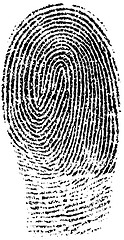
An assistant professor at Penn State has created a new statistical model that may enable fingerprint evidence to withstand greater scrutiny in court. Currently, some fingerprints that could be key pieces of evidence in court are not being considered because of shortcomings in the way this evidence is reported. Cedric Neumann, assistant professor of forensic science and statistics at Penn State, has devised a statistical model to enable the weight of fingerprint evidence to be expressed in quantitative terms, paving the way for its full inclusion in the criminal-identification process.
The findings were published in Significance, the magazine of the Royal Statistical Society and the American Statistical Association. A detailed research paper describing the study will be published later this year in the Journal of the Royal Statistical Society: Series A.
Fingerprints have been used for over a century as a way of identifying criminals; however, fingerprint evidence is not currently permitted to be reported in court unless examiners claim absolute certainty that a mark has been left by a particular suspect. This courtroom certainty is based purely on the opinion of experts, formed through years of training and experience, but not on scientific data. Less-than-certain fingerprint evidence is not reported at all, without regard for the potential weight and relevance of the evidence in a case.
In Neumann’s report in the Feb. 8 issue of Significance, he highlights the subjectivity in current processes, calling for changes in the fingerprint evidence is allowed to be presented.
“It is unthinkable that such valuable evidence should not be reported, effectively hidden from courts on a regular basis. Such is the importance of this wealth of data, we have devised a reliable statistical model to enable the courts to evaluate fingerprint evidence within a framework similar to that which underpins DNA evidence,” he said.
Neumann and his team devised and successfully tested a model for establishing the probability that a print could belong to a particular suspect. After mapping the finer points of detail on a “control print” from the suspect and a print obtained as evidence at the crime scene, the researchers tested two hypotheses. The first test — designed to establish the probability that the crime-scene print was made by the suspect — compared the control print with a range of other prints made by the suspect. The second test — to establish the probability that the crime-scene print was made by someone other than the suspect — compared the crime-scene print with a set of prints in a reference database. Neumann’s research team then calculated the likelihood ratio between the two probabilities. The higher the ratio indicating stronger evidence that the suspect was the source of the crime scene print.
“Current practice allows a state of certainty to be presented, in criminal-justice situations, which is not justified scientifically or supported by logical process or data,” Neumann said. “We believe that the examiner should not decide what evidence should or should not be presented. Our method allows all evidence to be supported by data, and reported according to a continuous scale.”
The research has received funding from Forensic Science Services in the United Kingdom, and it is receiving ongoing support from the National Institute of Justice of the U.S. Department of Justice.
For more information, contact Neumann at czn2@psu.edu; Penn State Eberly College of Science PIO Barbara Kennedy at 814-863-4682 or science@psu.edu;
or Significance Magazine PIOs Jennifer Beal, at +44 (0) 1243 770633, or Amy Molnar, at +1-201-748-8844. Significance Magazine also can be reached by email atphysicalsciencenews@wiley.com.


